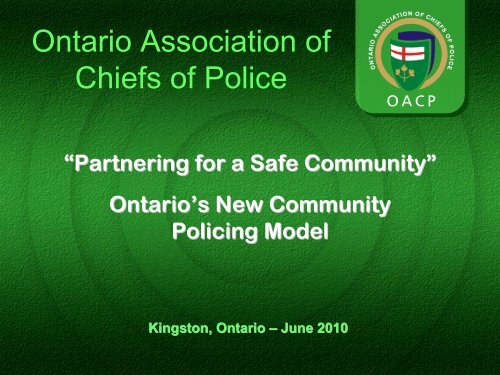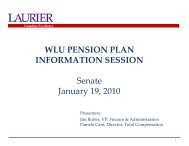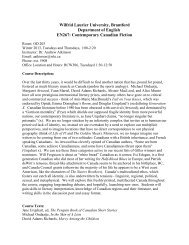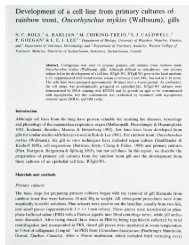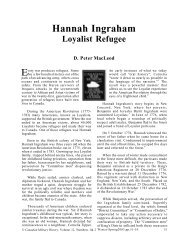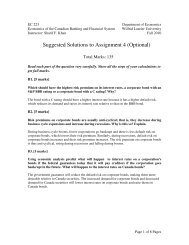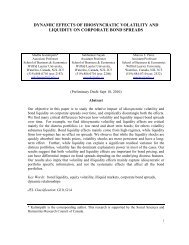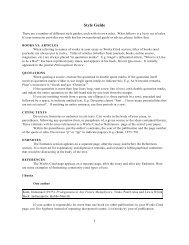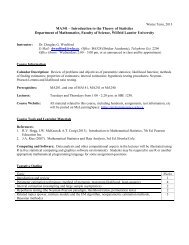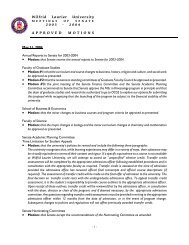Ontario Community Policing Model
Ontario Community Policing Model
Ontario Community Policing Model
- No tags were found...
Create successful ePaper yourself
Turn your PDF publications into a flip-book with our unique Google optimized e-Paper software.
<strong>Ontario</strong> Association ofChiefs of Police“Partnering for a Safe <strong>Community</strong>”<strong>Ontario</strong>’s s New <strong>Community</strong><strong>Policing</strong> <strong>Model</strong>Kingston, <strong>Ontario</strong> – June 2010
Agenda• Today we’re going to talk about…1. The new OACP <strong>Community</strong> <strong>Policing</strong> <strong>Model</strong> – whychange?2. The process of change.3. Introducing the New <strong>Model</strong>.4. New training at the <strong>Ontario</strong> Police College.5. Police leaders – what does the new <strong>Model</strong> mean tome and my Police Service?
The 1996 <strong>Community</strong><strong>Policing</strong> <strong>Model</strong>Why change the original 1996<strong>Model</strong>?
Drivers of change• <strong>Community</strong> mobilization• Crime prevention through socialdevelopment• Police community joint problemsolving• Meaningful to front line police officers
Consultation22 Weeks via Internet• 22 Police Officers (18 <strong>Ontario</strong> Services)• 20 Civilians (15 <strong>Ontario</strong> Communities)• 4 Ministry Officials• 2 OPC Officials• 50 Contributors
ConsultationDirect Consultation• OACP Zones and Committees• Individual Police Services• First Nations Police•OAPSB, PSAC• <strong>Community</strong> Groups
What Did They Say?“Police can support, lead, provide a role modeland assist in times of trouble but the ‘community’itself has to step up and take responsibility—beaccountable—for their safety and security....”
What Did They Say?“Citizens and community service providers mustbe...encouraged by this model to fulfill their rolein community policing...(in cooperation with thepolice)....”
What Did They Say?“One size does not fit all! ...each community andneighbourhood needs to be looked atindividually....”
What Did They Say?“...high-demand neighbourhoods have fewerresources, fewer service groups, smallerreligious congregations, and fewer positiveinteractions with police ...”
What Did They Say?...community partners in ‘safeneighbourhoods’...have assets like training andeducation, communication skills, experience inproblem-solving, networking, and financialresources ...”
What Did They Say?“...crime prevention measures like targethardening, CPTED and ‘watch’ programs workbest where they’re least needed – in relativelysecure neighbourhoods.... But where we’reresponding all the time, most of them cannot beeffectively implemented.”
What Did They Say?“The only way we can make standard crimeprevention measures work in high-demandneighbourhoods, is by eliminating the socialantecedents to crime and disorder.”
What Did They Say?“…reallocating police resources back to theareas of specialized law enforcement skills andaway from social worker interventions.”
What Did They Say?“...in unsafe environments, police need to focusinitially on enforcement and provide a level ofsecurity where people feel safe to come outsideand engage.”
What Did They Say?“The most effective crime prevention incommunities is community/police partnership.”
What Did They Say?“…partnerships have to be inclusive of allindividuals, agencies and organizations that areimpacted by, or have impact upon, the problemsto be resolved.”
What Did They Say?“...the process should really begin from themoment of hiring the officer....”
What Did They Say?“It is obvious...that community policing isrequired everywhere and that citizens from allareas need to step up, embrace it and help createand sustain community safety, security andwellbeing.”
What Did They Say?“Above all else, it helps citizens take better careof themselves and each other”.
<strong>Community</strong> <strong>Policing</strong>with a Purpose• Operationalize <strong>Community</strong> <strong>Policing</strong>• A diagnostic tool for police and community• Starts with a discussion defining <strong>Community</strong>• Contemplates the wide variety of policefunctions• Assessment of community capacity and needs
Unpacking <strong>Community</strong> <strong>Policing</strong>Enforcement & Crime Suppression• Crime analysis• Enforcement• Monitor crime reduction• Initiate problem-solving<strong>Community</strong> Engagement &Liaison• Liaison• Public education• Monitor at-risk groups• Partner in early-intervention<strong>Community</strong> Mobilization &Crime Prevention• Mobilize partners• Problem-oriented oriented policing• Monitor crime prevention<strong>Community</strong> Safety &Consultation• Engage leaders• Consultation• Monitor hazardsActions of Front Line Officers
<strong>Ontario</strong> Police College• OPC has been working with Dr. Hugh Russellon a <strong>Community</strong> <strong>Policing</strong> training package• April 2010 – work with community partnersand a working group of police servicesrepresenting:• <strong>Ontario</strong> Provincial Police• York Regional Police• Waterloo Regional Police• Chatham-Kent Police Service• Toronto Police Service
<strong>Ontario</strong> Police College• Mandate - create a learning package fordelivery to recruits commencing September2010• Three 90-minute periods will be devoted tounderstanding the model, problem-basedlearning scenarios, and group presentations
<strong>Ontario</strong> Police College• O.A.P.E. conference (<strong>Ontario</strong> Association of PoliceEducators) - late August 2010• Train-the-Trainer package – early 2011• <strong>Community</strong> Colleges
So what does this mean for Chiefsof Police and Police Leaders?• An opportunity to integrate “communitypolicing” operational philosophy throughouttheir organization – everyone has a role toplay• A common perspective, consistent language –across <strong>Ontario</strong>• <strong>Community</strong> can see where they fit in aspartners – model speaks to their involvementin policing
Business Planning• Adaptable to include:- concepts of the <strong>Model</strong> and include wherecommunity fits in – from consultative / surveyprocess to the development of enhancedrelationships and embedded partnerships• Help explain to Boards the strategies neededfor allocation or acquisition of resources
Questions?“Partnering for a Safe <strong>Community</strong>”Thank You!


